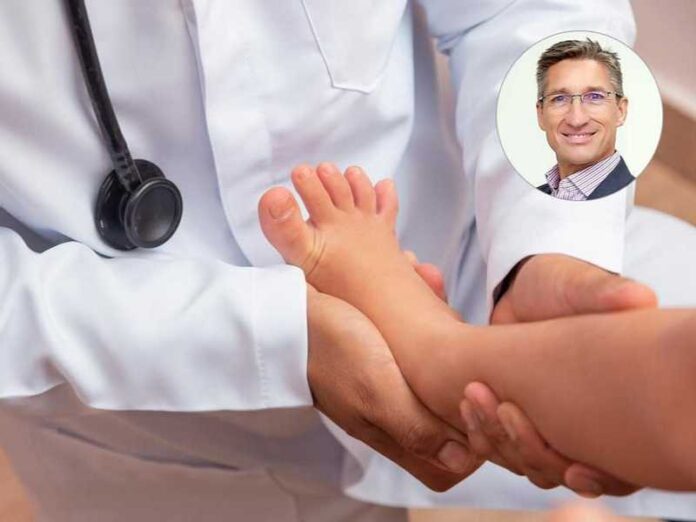There are many reasons why a child may need leg straightening surgery. The reason may be a congenital deformity, an accident, or a developing disease. This condition may be accompanied by shortening of one or both limbs, which requires the appointment of a specialized surgeon with experience in the field of bone lengthening and straightening.
The Al-Qabas daily met with Professor Dr. Michael Oglu, a specialist in bone restoration and treatment and lengthening of limbs at the Bali Middle East Clinic, in Burjeel Medical City, Dubai, where he explained that recent developments in operating techniques and available devices have contributed to increasing the chance of success of therapeutic and reconstructive operations for children and adults.
He said: “Children are affected by genetic conditions that are widespread in the Gulf, including cases that cause pelvic dislocation, abnormal growth of the limbs, and excessive thinning of the bones, all of which previously required the child to perform large and complex operations that may be accompanied by many complications and psychological, financial, and health problems.
However, with the development of medical technologies and the increase in doctors’ experience has made it possible to treat these cases through less invasive laparoscopic operations and the use of lighter external devices and anti-inflammatory screws.”
Dr. Oglu explained that one of the symptoms indicating abnormal (uncoordinated) growth in the child’s limbs or their deformity after he suffers a broken leg is that the parents notice a bow or limp in the child.
Here we advise that it be necessary to seek medical advice directly to measure the limbs and take appropriate advice. It may begin with a difference not exceeding one centimeter from one end to the other, and it may increase over time to become a large number of centimeters.
Therefore, it is advised not to delay in seeking a specialist doctor, and while some of these cases can be treated through surgery, many of them can be treated through drugs, physical therapy, and appropriate medical guidance, with monitoring for several months.
Dr. Oglu believes that if a child notices short stature, dwarfism, or shortness of one of his limbs, one of the available solutions is surgical operations to lengthen the limbs. But it is important to diagnose the cause of shortened limbs, even if it increases over time.
Dr. Oglu said that bone lengthening operations are among the real operations that are performed for medical reasons, such as treating dwarfism, problems with abnormal growth of limbs, and short stature.
He explained: “Through surgery, any deformity in the alignment of the bones (such as curved bones) can be corrected while increasing the length of the leg bones.
Dr. Oglu explained that, in general, the youngest age at which it is suggested to undergo surgical height increase operations is 7 years, and it can be repeated over three surgical stages until the bones reach the stage of maturity (adulthood).
The operations can achieve a lengthening of up to 30 cm in length over 3 procedures or treatment stages. He pointed out that an adult can undergo limb lengthening operations, but one surgical stage is often recommended, as each surgical stage can achieve a lengthening of 13 cm (8 cm in the thigh bones and 5 cm in the leg).
Dr. Oglu pointed out that each surgical stage of limb lengthening consists of two operations, the first focusing on an area in the lower extremities, whether it is the thigh or leg area. After 4 weeks of the first operation, the operation is performed on the next area in the lower limbs. It is not recommended to perform the operation on the thigh and leg area together because this doubles the chances of complications.
Dr. Oglu explained that a week after the surgical operation and ensuring that the wounds and tissues have recovered, the doctor begins to change the settings of the external device to begin the stage of increasing the length of the limbs, and according to the safe and internationally recommended rate, the operation aims to increase the length of the bones by an amount ranging between 0.75 and 1 millimeter per day.
Therefore, the patient’s length is expected to increase at a rate of 1 cm approximately every two weeks.
He added: “Throughout the treatment period, which often lasts for 5-6 months, the patient can be in the hospital or at home, but he must commit to a daily medical visit and move around by using devices (such as crutches and walkers) to remove weight from the limbs.
Dr. Oglu emphasized that after the treatment plan is completed to lengthen and mature the bones, they will become normal like any natural bone in the body, but longer than before. Bone is distinguished by its ability to build and repair any weakness, and the patient should not fear its thinning or weakness.
Dr. Oglu said that modern science has developed types of screws and solid anchors that are characterized by their anti-inflammatory ability, which has greatly reduced the incidence of infections to only 1-3 cases out of 50 surgical cases. Therefore, those planning orthopedic operations are advised to ask the surgeon about the type of screws and solid anchors used.
Important information:
- Adults are recommended to take one treatment stage to gain 13 cm in height.
- The duration of treatment may last from 5-6 months, with a commitment to medical follow-up.
- After the treatment is completed, the bones will become normal like any bone in the body.
- The treated bone is distinguished by its ability to rebuild and repair any weakness.
- Some cases can be treated with drugs and physical therapy.
- It is recommended not to delay seeing a doctor if you notice a bow or limp

















